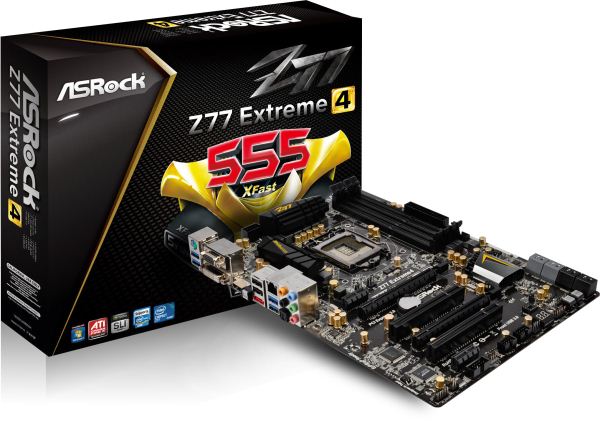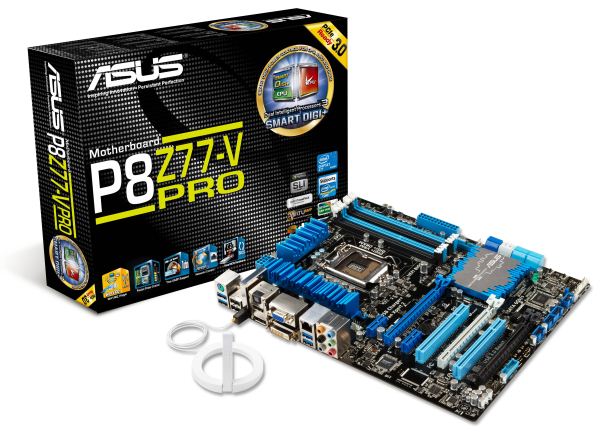Intel Z77 Motherboard Review with Ivy Bridge - ASRock, ASUS, Gigabyte, and MSI
by Ian Cutress on May 7, 2012 7:40 PM EST- Posted in
- Motherboards
- MSI
- Gigabyte
- ASRock
- Asus
- Ivy Bridge
- Z77
Conclusion – ASRock Z77 Extreme4
I had high expectations of the ASRock product due to what we have seen in previous chipsets. Over time, they have developed this knack of offering a good performance product at a great price, and a large amount of free kit in the box to sweeten the deal.
The Z77 Extreme4 is the lower end enthusiast board coming out from ASRock at release (compared to a total 20 models listed on their website). Therefore, when it comes in at $135, we should like this price. In the box is not substantial, with just a pair of SATA cables and an SLI finger, but we are treated to the ASRock BIOS and Software package. The big addition on the package is the Internet Flash software, allowing users to update their BIOS to the latest without needing to download it in an Operating System.
Performance wise, ASRock seem to be lacking the enhanced Turbo option utilized by other motherboard manufacturers by default, so we may see it in future BIOS builds. The XFast LAN software also shows superior performance in incompressible transfers or real-world transfers compared to standard USB throughput.
By making this board a little bit smaller than ATX, this board is cheaper than the rest and I really like the styling. As long as you remember to adjust the default CPU fan speed, this inexpensive board would be a good choice for an Ivy Bridge build.
Conclusion – ASUS P8Z77-V Pro
Whenever a reviewer deals with a variety of products at different price points, thoughts go through the mind of a reviewer about where that additional money has gone. If you look at an ASUS board, the usual culprits pop up - vastly improved fan controls, superior BIOS and software, digital power delivery, and a general feel that the board is solidly built. ASUS has gone another step further with their Z77 range, and on the Pro this means an Intel NIC as standard, onboard WiFi, USB Flashback, all four Ivy Bridge video outputs available, USB 3.0 Boost, Q-LED for POST diagnosis, and even a Thunderbolt header which connects to a future ASUS Thuderbolt add-in card (sold separately).
Performance on the P8Z77-V Pro is bolstered by the MultiCore Enhancement BIOS setting, which invokes maximum turbo mode for any core loading by default giving multi-threaded results an advantageous score. I feel this sort of setting will quickly become the standard, as motherboard manufacturers try to provide the best bang for buck on their products.
Despite the mishap regarding my CPU cooler (which is of an old design), there is not much I can complain about on the P8Z77-V Pro. It overclocked a set of G.Skill DDR3-2666 memory to DDR3-2950 with a little increase in voltage without issue, and it overclocked the CPU rather vigorously to give 4774 MHz, even if it was a little toasty under load.
At $225/$235, the motherboard spectrum for Ivy Bridge will separate the very cheap and the very functional. For a long-term build, the ASUS P8Z77-V Pro is a solid choice, and even has ASUS Premium Service warranty if you are in North America.
Update: I have just been informed that the Pro will soon drop in MSRP to $209. This makes it even more affordable.












117 Comments
View All Comments
Jase89 - Sunday, May 19, 2013 - link
Having RAID Option ROM Supported in UEFI as well (people using RAID) is a very good thing ASRock have done with their Z77 series, wonder when Gigabyte will add this feature, http://www.youtube.com/watch?v=Y1TbdVtAE9cgramboh - Tuesday, May 8, 2012 - link
Just wanted to add that my new P8Z77-V Pro POSTS significantly faster than what Ian experienced in this review, probably due to my configuration:Intel SATA: AHCI
ASmedia USB3: on
ASmedia SATA controller: off
Wifi: off
Onboard sound: off
My total time from splash screen to Windows 7 Pro x64 login is 15 seconds on a Mushkin Chronos Deluxe 240GB. The post is about 6 seconds (hand timing these). It's unfortunately the other controllers add ~14 seconds of POST time.
IanCutress - Tuesday, May 8, 2012 - link
Hi Gramboh,Disabling ASMedia SATA, Wifi and Sound would obviously decrease POST time by quite a bit! As I doubt the majority of non-enthusiast buyers would go into the BIOS and disable what they don't need, I kept the start up sequence the same as default to reflect this.
Ian
DanNeely - Tuesday, May 8, 2012 - link
A large number of your readers are enthusiasts. Giving both sets of numbers would be beneficial for us. A per onboard device breakdown of boot time would be nice; but probably too much work to be justified.IanCutress - Tuesday, May 8, 2012 - link
I've added 'POST Quick' to my internal database of testing, with the aim to turn off all I can to observe POST times. Will be applied from the next review onwards, perhaps retroactively if I get time.Ian
AlexIsAlex - Wednesday, May 9, 2012 - link
Awesome, thank you so much!Perhaps the manufacturers will pay attention to this too :-)
Paapaa125 - Wednesday, May 9, 2012 - link
I think most Anandtech readers DO go to BIOS to set things up. I think it is crucial to know if the differences in performance (boot time, benchmarks, power consumption etc) can be minimized just by changing BIOS settings. That would make it a lot easier to buy a new board.I have seen reports that some boards don't follow the Intel specs regarding Turbo Boost settings and utilize higher frequency with all cores utilized. This skews the performance results greatly. Those following the specs get worse results - yet they could be configured for exact same performance.
dananski - Tuesday, May 8, 2012 - link
Makes me really glad to have ordered the ASRock, though I wonder how it would be affected by having RAID enabled? My GA-P35C-DS3R takes about a minute to get through POST and RAID screens.I am also confused why even the quick one is taking so long. My laptops take less than 5 secs to POST :/
EnzoFX - Monday, May 7, 2012 - link
ATX just seems like it's for bragging rights, and not even directly so, simply because you'll be able to say you have so many things connected, maybe you even have tri or quad SLI, all in a huge case. Can we get some coverage of mATX boards?On another note, something that drives me nuts is the AHCI driver loading at POST. Last time I checked I couldn't find a straight answer, does this loading stage still happen in ivy bridge? Of course you don't have to use AHCI, but it really should be standard and enabled by default. At least for anyone spending this much on a motherboard.
EnzoFX - Monday, May 7, 2012 - link
"Conclusion – Gigabyte MSI Z77A-GD65"One more rant lol. Is having all 4 video outputs really a feature? Is this not targeted at people who will be using their own graphics card? In which case they only serve to use up space that could be used towards USB ports or something else that's almost as useful. Remember before P55, 10 usb ports were starting to be the average on a feature filled board, now we have to settle for 6-8. Unless you want to spend top dollar for more.